19th December Calendar
This December calendar, found behind Lakeport’s North Parlor, lines up with dates in 2018. The calendar is most likely late 19th century. Possible years are 1906, 1900, 1894, 1883 or 1877.
This December calendar, found behind Lakeport’s North Parlor, lines up with dates in 2018. The calendar is most likely late 19th century. Possible years are 1906, 1900, 1894, 1883 or 1877.
Saturday, December 8, 1 pm – 4 pm
Pick up a holiday present for your history buff on December 8 at the Lakeport Plantation. Local and regional authors will be on hand to sign copies of their books. Authors include:
Mark K. Christ of Little Rock, AR
Mark Spencer of Monticello, AR
Jim Woodrick of Ridgeland, MS
Woody Woods of Madison, MS
Princella Nowell of Greenville, MS
Robert Fulford of Dermott, AR
Blake Wintory of Lake Village, AR
Please bring cash or check. See books and prices below. Prices include tax. Hope to see you then!
Titles for Mark Christ:
Civil War Arkansas, 1863 ($22)
“This Day We Marched Again”: A Union Soldier’s Account of War in Arkansas and the Trans-Mississippi (ed. by Christ) ($24)
A Confused and Confusing Affair: Arkansas and Reconstruction (ed. by Christ; chapter by Blake Wintory) ($22)
Jim Woodrick:
The Civil War Siege of Jackson Mississippi ($24)
Woody Woods:
A Delta Diary: Amanda Worthington’s Civil War Diary ($22)
Delta Plantations: The Beginning ($22)
Princella Nowell:
Washington County, Mississippi (Images of America Series) ($24)
Mark Spencer:
Monticello (Images of America) ($24)
Mark will have other titles available, including– A Haunted Love Story: The Ghosts of the Allen House
Blake Wintory:
Chicot County (Images of America) ($24)
A Confused and Confusing Affair: Arkansas and Reconstruction (ed. by Christ; chapter by Blake Wintory) ($24)
Robert Fulford:
Growing Up on Yellow Bayou Book 1 ($12)
Growing Up on Yellow Bayou Book 2 ($12)
Dark Days of the South ($12)
The Wetherbee House, built around 1873 for Hiram E. and Dora Wetherbee, is the oldest and last remaining home in downtown Greenville. Wetherbee, a Kentucky-born Union Civil War Veteran, returned to the Delta after the Civil War and founded a prosperous hardware store in Greenville. The home was added to the National Register in 1977. Today, it is under renovation to become Wetherbee’s, a retail space.
1842 — Hiram E. Wetherbee is born in Boone County, Kentucky.
1860 — Wetherbee, an 18 years-old farmer, is living in Golconda, IL along the Ohio River. He and six siblings are in the household of his father, T. W. Wetherbee, a wagon maker.
1862, August 16 — Wetherbee enlists at Golconda in 120th Regiment Illinois Infantry Volunteers, Company E as a teamster/wagoner. A younger brother, Wesley O. Wetherbee, joined the 29th Illinois Volunteer Infantry in 1864.
1862-1865 — The 120th IL Infantry transfers to Memphis, Tennessee. The 120th participated in the siege of Vicksburg (May-June 1863) and spent time in Old Greenville.
1865, September 10 — Wetherbee is discharged from the Union Army at Memphis.
1867-1870 — Wetherbee likely arrives in new Greenville. He initially farmed and worked as a tinsmith. In the 1870 Census, he has $1000 in real estate and $700 in personal property. His neighbor is Samuel Elliot, an Indiana-born hardware dealer who was appointed Greenville’s postmaster in 1868.
1871 — Wesley O. Wetherbee, Hiram’s younger brother and a Greenville blacksmith, marries Belle V. Elliott.
1873 — Wetherbee purchases land from Mrs. Blanton Theoblad, where he would build his home.
1874, October 3 — Advertisements for Wetherbee & Brown Hardware appear in The Greenville Times. Records suggest the hardware store was located on the now lost Mulberry Street parallel to the Mississippi River. In 1885, the store was relocated to Walnut Street.
1874, October 28 — Wetherbee weds Dora McCoy at Golconda, Illinois. The couple raise three children: Harry Lon (1875), Edna (1877), and Ethel (1895).
1878, September 30— Wesley O. Wetherbee, Hiram’s younger brother and a Greenville blacksmith since at least 1871, dies. His death coincides with the yellow fever epidemic. He is buried in Arlington National Cemetery.
1905 — Wetherbee dies and is buried in the Greenville Cemetery. Wetherbee’s son, Harry, takes over the hardware store.
1911 — Dora Wetherbee dies and is buried in the Greenville Cemetery.
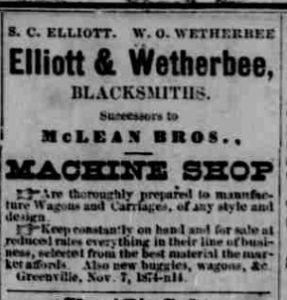
Wesley O. Wetherbee worked as a blacksmith according to this November 4, 1874 advertisement in The Greenville Times
1950 — Wetherbee Hardware Store claims to be the oldest in the state of Mississippi.
1957 — Wetherbee Hardware Store is sold to new owners. It closed in 1966.
1973 — Ethel Wetherbee Finley is the last Wetherbee to live in the home.
1973 — The Council of Greenville Garden Clubs purchases the home. Under an architect’s supervision, the house is restored to its 1870s design and used as a clubhouse and museum.
1977 — The Wetherbee house is added to the National Register “as a rare example of the modest cottage type of domestic architecture common…in the post-Civil War decades” in Greenville. The Wetherbee carriage house is believed to be pre-Civil War.
Note: In addition to the National Register nomination, Mrs. Robert M. Harding’s 1978 article, “The Historic Preservation of the Wetherbee House,” published by the Washington County Historical Society is a good source of information on the Wetherbees and the home. Other sources consulted include U.S. Census records, Greenville Times, Delta Democrat-Times, Hiram Wetherbee’s pension file at the National Archives, among others.
Just behind the Lakeport house is a small children’s cemetery with post-Civil War burials of Lycurgus and Lydia Johnson’s children and grandchildren. Unprotected for many years, markers had been lost–some apparently drug into the field by tractors. Before restoration, the small crypt was the only for sure burial. Parts of four small markers were eventually discovered and ground penetrating radar revealed that there are at least two other burials and likely a third.
Of the four markers, only two have initials: “C.J.” for Cable Johnson (b. March 15, 1865; d. August 5, 1867) and “L.J.S.” for Lydia J. Starling (b. October 19, 1879; d. 1882). The third and fourth markers do not have any visible initials. Those markers are likely for Julia J. Johnson (b. July 12, 1860; d. November 1, 1869) and Lucie C. Worthington (b. January 8, 1880; d. June 5, 1881).

Parts of four markers were found around the children’s cemetery. Only two had any identifiable marks.
However, a recently discovered record suggests there is a fifth child buried in the cemetery.
Emma Peak and Walter Johnson married at Grand Lake, Chicot County on January 7, 1886. Emma, writing in 1937 in an unpublished memoir, stated, “Shortly afterwards we moved north to Wilton [Iowa] to be near Mr. Johnson’s business.” In a chapter titled, “Baby John,” she writes about the loss of her first child: “My first baby was a plump little boy with lovely large light blue eyes and red curls. A baby with lovely disposition. He loved people and would go to everybody who held out their arms to him….Little John stayed with us for fourteen months a baby loved by everyone.”
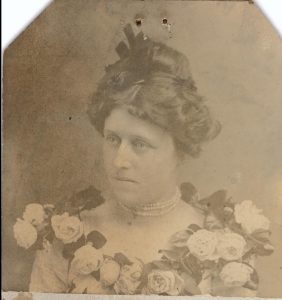
This ca. 1890 photograph of Emma Peak Johnson, taken in Wilton, Iowa, was found behind the drawing room mantel during restoration.
According to Iowa, County death records, 1880-1992, John P. Johnson, 13 months old, died on July 25, 1888 in Wilton Junction, Iowa. The record shows he was buried at Lakeport, Arkansas, very likely with his cousins behind the Lakeport family home.

Lycurgus and Lydia chose to bury their children who died before the Civil War in Frankfort, Kentucky and would eventually join them in 1876 and 1898. Unlike their parents, the Johnson daughters, Annie Starling and May Worthington, as well as Emma and Walter Johnson and chose their childhood home, Lakeport, as the place to bury their children–even sending little John Peak Johnson all the way from Iowa.
Notes (updated December 12, 2018):
The cast iron fence was added around the cemetery was added in 2008. A gift of Annie Paden, a descendant of Mary (May) Johnson Worthington, the iron fence surrounded Annie Taylor Worthington Spencer’s home on the Glen Allan Plantation in Glen Allan, MS.
Lydia Starling (1879-1882) was the daughter of Annie Johnson Starling (daughter of Lycurgus and Lydia Johnson) and Charles Hensley Starling. Nine-year-old Julia J. Johnson died in November 1869 about eight months after her brother, Cable. Lucie Worthington (1880-1881) was the daughter of Mary (May) Johnson and Isaac M. Worthington, Jr.
A copy of Emma Peak Johnson’s unpublished 1937 memoir, Growing Pains are Heaven, is on file at the Lakeport Plantation.
John P. Johnson’s death is indexed as “John P. Jackson,”https://www.familysearch.org/ark:/61903/1:1:XVQR-BM4 but it is clear in the original that it is “Johnson.”
Also see this post from 2012 —
Visit Lakeport Plantation for free during the Thanksgiving Holiday. The house will be open to explore with toys and games, Christmas tree decorating, and gift shop sale!
Bring your family for a visit!
November 23-25
Gift Shop Discounts and Explore the History at Lakeport
See updates on Facebook event page
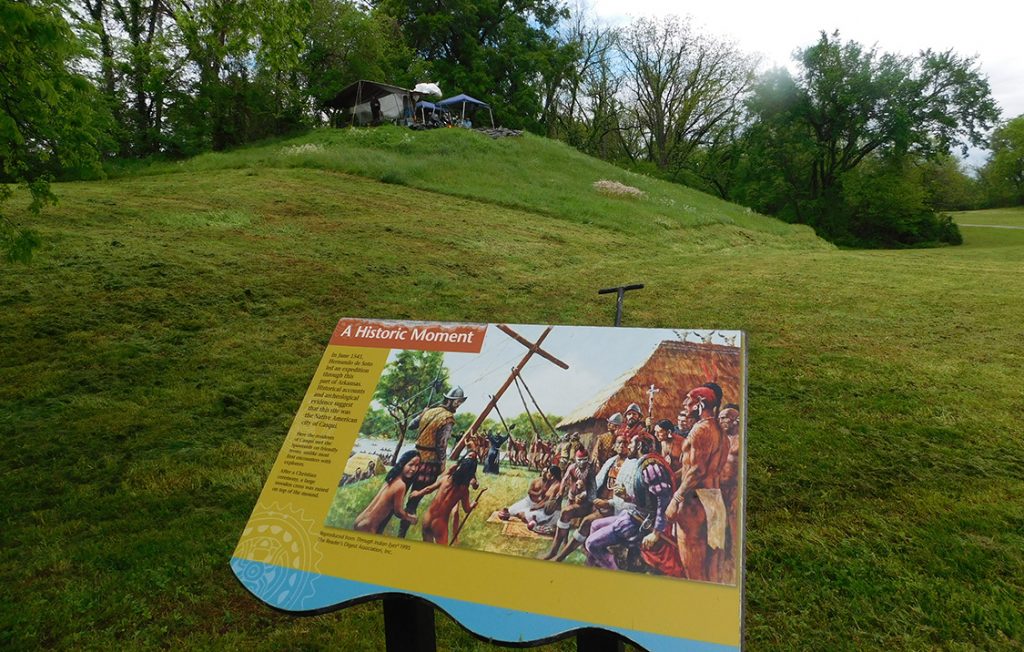
All four de Soto narratives describe the erection of a cross on the main ceremonial mound at Casqui. The site has been a National Historic Landmark since 1964 and an Arkansas State Park since 1994. Photo courtesy The Archaeological Conservancy.
On July 5, 1541, the Hernando de Soto expedition erected a large wooden cross atop the main ceremonial mound at Casqui. That site is believed by archeologists to be the Parkin Site in Cross County, Arkansas.
In 1966, archeologists discovered the remains wooden post atop in the main ceremonial mound. While samples taken in 1966 dated to the post to between (1515-1663). A new excavation of the post in 2016 holds the promise of precision and a date closer to de Soto’s arrival in what is now eastern Arkansas.
(by phone, email or online)
870.265.6031 ·
601 Hwy 142 · Lake Village, AR 71653
Thursday, August 23
Refreshments & Conversation @ 5:30 pm
Program @ 6:00 pm

Dr. David War, Arkansas Capitol Historian, is the author of It’s Official!: The Real Stories behind Arkansas’s State Symbols, now in its 2nd edition.
Arkansas’s Capitol Historian, Dr. David Ware, will discuss the utility of symbols, the significance of Arkansas’s earliest adopted symbols and will conclude with some observations on the potential for using the state symbols in interpreting the state’s history, geography and even its economic profile. And tell a couple of sea stories along the way.
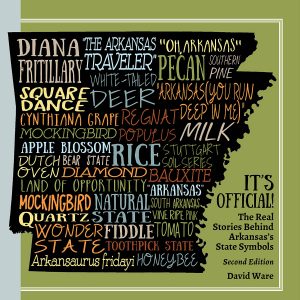
Copies of It’s Official!: The Real Stories behind Arkansas’s State Symbols will be available for purchase for $24 each.
(by phone, email or online)
870.265.6031 ·
601 Hwy 142 · Lake Village, AR 71653
Thursday, July 19 — Encore Presentation on Thursday, July 26
Refreshments & Conversation @ 5:30 pm
Program @ 6:00 pm
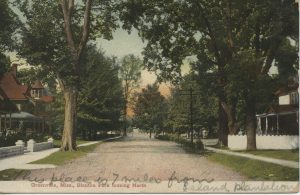
Blanton Park, Greenville, Miss. looking North, ca 1911. Image courtesy of Ann Rayburn Paper Americana Collection, Special Collections, University of Mississippi Libraries
Blanton Park emerged as a downtown neighborhood in 1886 from Harriet (Blanton) Theobald’s old homeplace. In 1865, Theobald donated part of her plantation for the town of “New Greenville” just behind Island No. 83 on the Mississippi River. After her death, her surviving son, Orville M. Blanton, subdivided her personal property into Blanton Park. Blanton Park became a residential subdivision with homes of family members, professionals, and politicians. On its corners and edges were churches, businesses, clubs, and the Greenville Sanitarium. Washington County Historian Princella Nowell will explain how the “Park” was subdivided, who lived there, and what eventually happened to the homes and churches as they were abandoned to fire, flood, and neglect.
Register for this FREE Event (Registration is closed for July 19) Register for July 26
(by phone, email or online)
870.265.6031 ·
601 Hwy 142 · Lake Village, AR 71653
Thursday, June 21
Refreshments & Conversation @ 5:30 pm
Program @ 6:00 pm
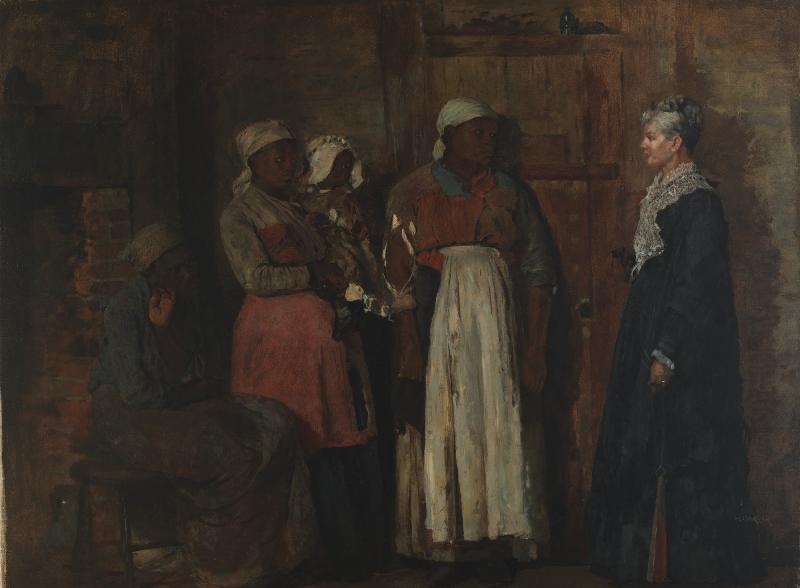
Winslow Homer’s A Visit from Mistress (1876) exemplifies the tensions between former slaveholders and their former slaves in the years after the Civil War. Smithsonian American Art Museum, Gift of William T. Evans, 1909.7.28
Lakeport Legacies for June 21 will feature Dr. Gary T. Edwards. Edwards, associate professor of history at Arkansas State University, will examine the life of Amanda Trulock (1811-1891). Born and raised in Connecticut, Trulock was widowed in 1849 and found herself the mistress to 62 enslaved laborers on a plantation in Jefferson County. Letters and plantation records reveal a complicated relationship with slaves as she managed her plantation near Pine Bluff. Edwards’ chapter on Trulock was recently published in Arkansas Women: Their Lives and Times (University of Georgia Press, 2018). A limited number of copies will be available for purchase.
Arkansas Women: Their Lives and Times — $35
Register for this FREE Event
(by phone, email or online)
870.265.6031 ·
601 Hwy 142 · Lake Village, AR 71653
